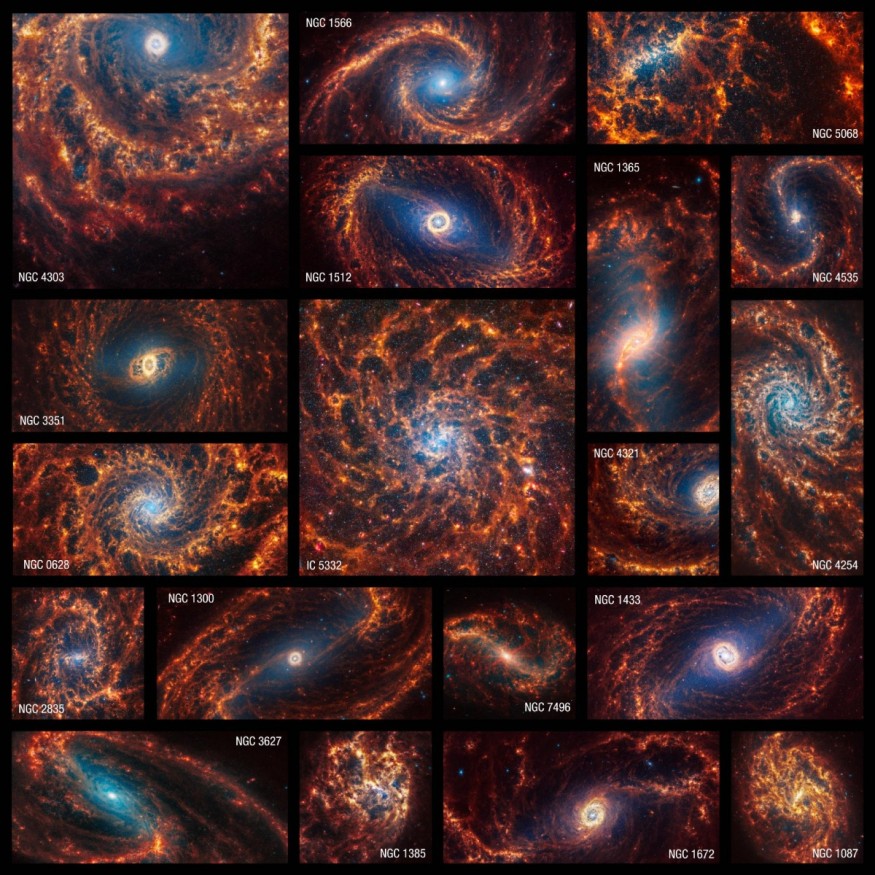The James Webb Space Telescope (JWST) has unveiled detailed images of 19 Milky Way-like spiral galaxies, showcasing stars, gas, and dust with unprecedented precision. Described as extraordinary and mind-blowing by scientist Janice Lee, these images reveal the galaxies at the smallest scales ever observed beyond our own.
The stunning detail has captivated even seasoned researchers who have studied these galaxies for decades, marking a significant advancement in astronomical observation capabilities.

JWST Unveils Unprecedented Views of the Universe
JWST was launched on Christmas Day in 2021 and continues to stand out for its unparalleled ability to capture highly detailed images of distant objects in the universe.
Equipped with near- and mid-infrared cameras, the telescope can perceive light in the infrared spectrum, invisible to the human eye. This capability enables scientists to visualize dust clouds and objects concealed within them, including those too faint for traditional telescopes.
The recently captured spiral galaxies vary in distance from 15 million to 60 million light-years from Earth, showcasing stars as blue pinpricks of light. Some stars are dispersed in pinwheel-like arms typical of spiral galaxies, while others cluster in the galaxy centers.
Evidence supports the idea that spiral galaxies grow from the inside out, with blue clumps at the cores indicating older star clusters, while the arms likely contain younger stars, as suggested by the European Space Agency.
The images also reveal clouds of red and orange, representing dust surrounding stars, and spherical shapes hinting at remnants of exploded stars. Pink and red emanating from galaxy cores may originate from supermassive black holes, concentrations of matter hundreds of thousands of times more massive than our sun.
Part of the Physics at High Angular Resolution in Nearby Galaxies (PHANGS) survey, these images contribute to understanding star formation physics by cataloging an unprecedented number of stars.
Adam Leroy, a PHANGS team member, and astronomy professor at The Ohio State University, emphasized the importance of precisely cataloging various star types to build a more reliable and holistic view of their life cycles, considering stars' potential longevity spanning billions or trillions of years.
How Common Are Spiral Galaxies?
Galaxies are categorized into spiral, barred spiral, elliptical, and irregular. Spiral galaxies, constituting around 60% of all galaxies, have a central bulge within a rotating disc featuring spiral arms. Barred spirals, comprising two-thirds of spirals, differ as their arms connect to a straight bar leading to the nucleus.
Classifying spirals can be challenging due to varying appearances based on their orientation, with 'face-on' and 'side-on' being the extremes. The Milky Way is believed to be a barred spiral, hosting the majority of the Universe's stars, which are generally younger than those in elliptical galaxies.
Spiral galaxies, including those with bars, present a puzzle in modern astronomy regarding the stability of their rotating spiral arms. JWST's detectors are well-suited for studying spiral galaxies, offering insights into their growth and evolution. Examples of spiral galaxies include Stephan's Quintet, NGC 7496, NGC 1433, and M74, revealing details about their structures, bar presence, and arm regularity.
RELATED ARTICLE: James Webb Space Telescope Reveals Unprecedented Glimpse of Galaxies Merging in a Surprising Discovery
Check out more news and information on the James Webb Space Telescope in Science Times.












